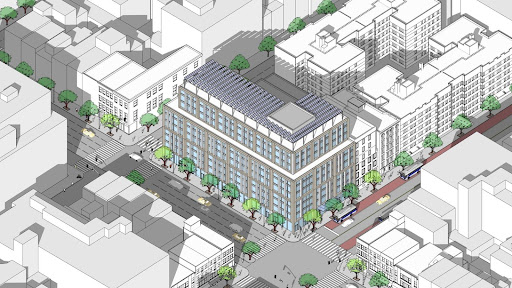Mayor Adams’ ‘City of Yes’ housing proposal includes a 20 percent density bonus for developers—if the additional units are income-restricted. While City Hall has yet to finalize exact affordability levels, officials said they would be aimed at households that earn lower than 80 percent of the Area Median Income, roughly $101,680 for a family of three.


Above: These before-and-after graphics illustrate how the 20 percent density bonus under the Universal Affordability Preference could add additional units to a project. (NYC Dept. of City Planning)
By shaking up and abolishing a few of the city’s “antiquated” zoning requirements, Mayor Eric Adams and the Department of City Planning (DCP) seek to produce 100,000 additional homes over the next 15 years through the administration’s wide-ranging “City of Yes for Housing Opportunity” proposal.
A major component of that plan, called the Universal Affordability Preference or UAP, would offer a 20 percent density bonus for developers, with the caveat that the additional housing units are affordable.
“Our goal is to create ‘a little more housing in every neighborhood’ to finally tackle New York’s housing shortage head-on,” DCP Director Dan Garodnick said after Mayor Adams announced the initiative in September. “By addressing the root cause of New York’s high housing costs, displacement, homelessness, and the imbalance of power between tenants and landlords, we can build a city where working families can thrive.”
At a virtual public information session Tuesday, city housing officials detailed some of their vision for the UAP. If approved, it would replace the current Voluntary Inclusionary (VIH) Housing program, which since 1987 has allowed developers in certain areas to build additional density if they include a portion of income-restricted units.
UAP, by contrast, would apply to a wider swath of the city—all of its medium and high density areas, officials said—and require units be affordable to lower income brackets than VIH, which is set at 80 percent of the Area Median Income (AMI), equivalent to $101,680 for a family of three.
“We recognize that 80 percent AMI doesn’t meet the needs of New Yorkers who need affordable housing, especially as AMIs have risen dramatically in recent years,” Winnie Shen, a housing planner with DCP, said at the session.
UAP would also allow for income averaging—in which a project can include a mix of units set at different AMIs—something that isn’t permitted under VIH, which has resulted in “a glut of units at 80 percent AMI,” Shen said.
But officials stopped short of detailing the exact affordability levels for the new program, something DCP has indicated it plans to hash out before the initiative goes to public review in the spring, culminating in a final vote by the City Council anticipated in the fall of 2024.
John Mangin, head of the housing division at DCP, noted that there would be no one-size-fits-all approach. “We do not want to create affordable units just at one AMI. We know housing costs in New York City are out of control and we want to create affordable units for families at a range of incomes,” he said.
When asked about pairing UAP with a possible tax abatement, such as a renewal of 421-a currently being negotiated in the state government, Mangin thinks the benefits would be substantial and allow for more privately developed, mixed-income housing—but only if a deal can be made.
“The city is advocating with our state colleagues and counterparts for a renewal in some form of a tax benefit that will work in conjunction with UAP to produce tens of thousands of affordable housing units in the decade ahead as long as they can work together,” he said. “In the absence of a tax benefit for multifamily housing, we don’t expect to see much, if any mixed-income rentals at all.”
The city’s Mandatory Inclusionary Housing (MIH) policy—a measure introduced by former Mayor Bill de Blasio mandating developers allocate 20-30 percent of units for affordability in areas rezoned for increased housing—is poised to gain advantages from UAP as well.
Under the plan, MIH neighborhoods will persist and be enforced in zones experiencing significant housing density growth. In MIH zones where the Floor Area Ratio (FAR) falls below that of the UAP, MIH will adjust the FAR to align with UAP standards. The FAR, specific to each zoning district, determines the maximum floor area permitted on a zoning lot by multiplying it with the lot area.
According to the DCP, the “City of Yes” housing initiative is the first time a mayor has proposed more housing across the entire city, and is presently going through what Mangin believes may be the largest environmental review the city has undertaken.
In addition to the UAP, the proposal calls for measures to end parking mandates that are traditionally required with new housing developments, permit the conversion of office buildings left vacant by the COVID-19 pandemic into affordable homes and supportive housing, while ending other restrictions on residential development.
The plan also proposes development on aging large campuses, removing building height restrictions on narrow properties imposed by the “sliver law”—originally created to prevent the construction of tall and narrow buildings in certain zoning districts—and new means for landmarked buildings to sell unused development rights to raise maintenance revenue.
Future public information sessions on “City of Yes for Housing Opportunity” will be livestreamed in the coming months with three more sessions to come before the end of April, each going over a different aspect of the proposal. You can register for these live sessions and get more information here.
To reach the reporter behind this story, contact Chris@citylimits.org. To reach the editor, contact Jeanmarie@citylimits.org








